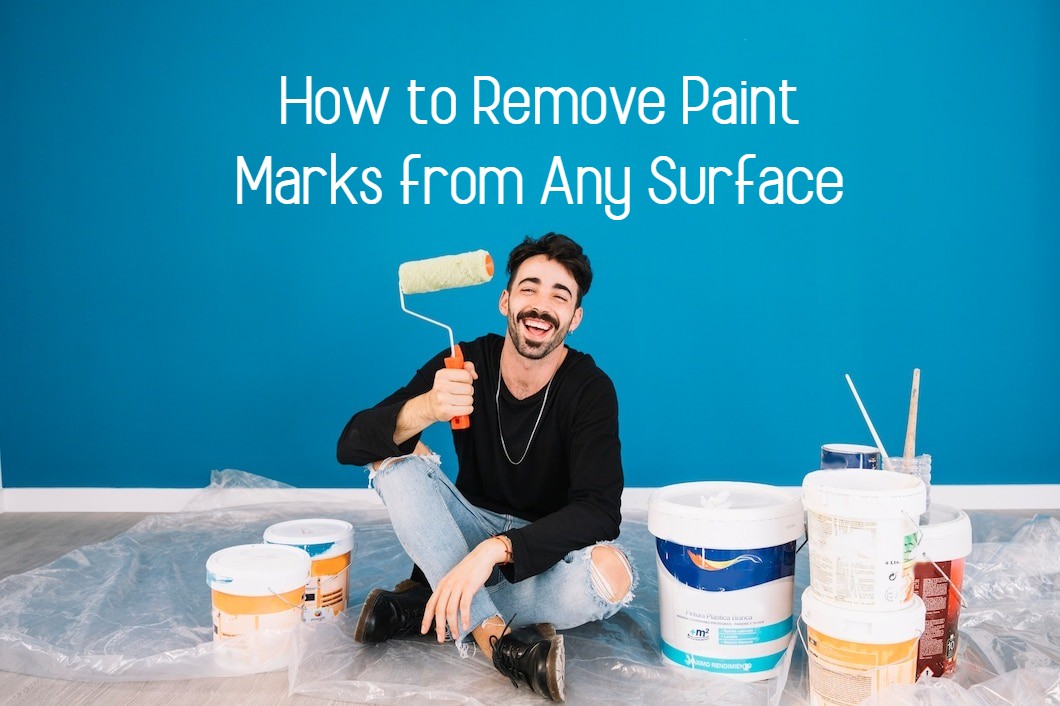Introduction
Paint marks can be a source of frustration, but with the right techniques, you can effectively eliminate them from a variety of surfaces. This article will guide you through a step-by-step process for removing paint marks from different surfaces, ensuring your spaces look pristine once more.
Gathering Your Supplies
Before you embark on paint mark removal, it’s crucial to gather all the necessary supplies. The specific tools and materials you’ll need can vary depending on the surface and type of paint. Here’s a more detailed breakdown of some of the supplies:
- Paint Removers: Depending on the type of paint, you may need either water-based or oil-based paint removers. These are essential for breaking down the paint’s adhesion to the surface.
- Solvents: Mineral spirits and acetone are common solvents used to remove paint. They work well for oil-based paints and stubborn paint marks.
- Cleaning Agents: Mild soap, vinegar, baking soda, and commercial glass cleaners are essential for different surfaces. These agents help dissolve paint and aid in the removal process.
- Brushes: Soft-bristle brushes, scrub brushes, or even old toothbrushes can be useful for scrubbing away paint marks.
- Protective Gear: Safety should be a priority. Gloves, safety goggles, and a mask are crucial when working with paint removers and solvents.
- Razor Blades: Razor blades or scraper tools come in handy for removing paint from glass surfaces.
Having these supplies at hand will make the process smoother and more efficient.
Identifying the Surface
Understanding the type of surface you’re dealing with is essential, as different surfaces react differently to paint removal techniques. Let’s explore this in more detail:
- Wood Surfaces: Wooden surfaces require special care to avoid damaging the finish. It’s important to distinguish between painted and stained wood. Painted wood can often be sanded or heated to remove paint, while stained wood may need a different approach.
- Fabric: Removing paint from fabric can be tricky. The method you use will depend on whether the paint is wet or dry. It’s crucial to take care not to damage the fabric during removal.
- Glass: Glass surfaces are delicate and can be scratched easily. Using the right tools and techniques, like razor blades or commercial glass cleaners, is crucial to avoid damage.
- Concrete and Brick: Outdoor surfaces like concrete and brick may require power washing or the use of chemical paint strippers. These methods can effectively remove paint without harming the underlying surface.
- Metal: When dealing with metal surfaces, consider whether the metal is painted or coated. Sanding and repainting can often restore the original finish, while solvents can be used for stubborn paint marks.
- Walls: Painted walls can be cleaned using mild detergent and water or magic erasers. The type of paint and the finish on the walls will determine the best approach.
How to Remove Water-Based Paint
Using Soap and Water
Water-based paints are generally easier to remove. Mixing mild soap with warm water and gently scrubbing the paint marks can often suffice. Rinse and repeat until the paint is completely removed.
Utilizing Vinegar and Baking Soda
For more stubborn water-based paint stains, creating a paste using vinegar and baking soda is effective. Apply the paste to the affected area and scrub with a soft cloth or sponge. This method helps break down the paint for easier removal.
How to Remove Oil-Based Paint
Oil-based paint can be more challenging to remove due to its durable nature. Here are two effective methods:
Applying Mineral Spirits
Mineral spirits can effectively dissolve oil-based paint. Soak a cloth in mineral spirits and gently rub the paint marks. This should help break down the paint for removal.
Employing Acetone
Acetone is another potent solvent for removing oil-based paint. Apply acetone to a cloth and carefully wipe away the paint marks. Be cautious and work in a well-ventilated area when using acetone.
How to Remove Paint from Wood Surfaces
Wood surfaces can be particularly sensitive to paint removal. Here are two methods to consider:
Sanding the Surface
Sanding is a viable method for removing paint from wood. Begin with a fine-grit sandpaper and gradually move to coarser grits as needed. Sanding carefully ensures that you remove the paint without damaging the wood’s finish.
Using a Heat Gun
A heat gun can soften the paint, making it easier to scrape off. However, this method requires caution to avoid scorching the wood or creating toxic fumes. It’s recommended for experienced users.
How to Remove Paint from Fabric
Removing paint from fabric requires care to avoid causing further damage. Here’s how to address paint stains on fabric:
Scraping Off Dried Paint
If the paint is dry, gently scrape off as much as possible without damaging the fabric. Use a dull knife or the edge of a credit card to lift the paint.
Treating Wet Paint Stains
If the paint is still wet, blot the area with a paper towel to absorb excess paint. Avoid rubbing, as this can spread the paint. Rinse the stained area with cold water, which helps prevent the paint from setting. If the stain persists, consider using a fabric-specific stain remover.
How to Remove Paint from Glass
Removing paint from glass requires precision to avoid scratches or damage:
Razor Blade Method
Carefully use a razor blade at a shallow angle to scrape off paint. Keep the glass wet with soapy water or a glass cleaner to reduce friction and avoid scratches. It’s essential to exercise caution while using this method.
Commercial Glass Cleaners
Commercial glass cleaners can also help dissolve paint marks from glass surfaces. Apply the cleaner and use a soft cloth to gently rub away the paint.
How to Remove Paint from Concrete and Brick
Concrete and brick surfaces outdoors can be a bit more challenging to clean. Here are two effective approaches:
Power Washing
Power washing is an excellent method for removing paint from concrete and brick. The high-pressure water stream can dislodge paint and reveal the clean surface beneath.
Chemical Paint Strippers
In cases where power washing alone isn’t sufficient, chemical paint strippers can be used. These products help break down the paint, making it easier to remove. Be sure to follow safety precautions when using chemical paint strippers.
How to Remove Paint from Metal Surfaces
Metal surfaces can often be restored to their original condition after paint removal:
Sanding and Repainting
For metal surfaces, sanding followed by repainting can effectively eliminate paint marks. Start by sanding off the paint, then apply a primer and a fresh coat of paint to restore the metal’s appearance.
Using Solvents
Solvents like acetone or mineral spirits can also work on metal surfaces to remove paint. Apply the solvent to a cloth and gently rub away the paint. Ensure proper ventilation and safety precautions when using solvents.
How to Remove Paint from Walls
Cleaning painted walls requires care to preserve the paint finish:
Mild Detergent and Water
Mix mild detergent with water to create a gentle cleaning solution. Use a soft cloth or sponge to clean painted walls, paying attention to the paint’s finish. Rinse with clean water and dry with a soft towel.
Magic Erasers
Magic erasers are specially designed to remove stains from painted surfaces. They can be a quick and effective solution for small paint marks on walls. Gently rub the magic eraser over the paint mark to remove it.
How to Remove Paint From Carpet
Paint spills on your carpet can be distressing, but with the right approach, you can salvage your beautiful floor covering. Here’s what you need to do:
- Act Fast: The sooner you address the spill, the better. Blot the wet paint with a paper towel or cloth to remove as much as possible.
- Use Dish Soap: Mix a solution of dish soap and warm water. Apply it to the stain and gently scrub with a soft brush or cloth.
- Rinse and Repeat: Rinse the area with clean water and blot it dry. Repeat the process until the paint stain is gone.
How to Remove Paint From Countertops
Countertops are prone to paint splatters during DIY projects. Here’s how to get rid of those stubborn marks:
- Scrape Off Excess: Use a plastic scraper to gently remove dried paint.
- Use Acetone: Dampen a cloth with acetone or nail polish remover and rub it on the stain. Be cautious with sensitive surfaces.
- Rinse and Wipe: Rinse the countertop with water and wipe it clean. Avoid using abrasive materials to prevent damage.
How to Remove Paint From Floors
Paint spills on your flooring can be unsightly, but you can restore their beauty with these steps:
- Scrape Off Dried Paint: Use a plastic putty knife to carefully scrape off dried paint from hard floors.
- Use a Solvent: For stubborn stains, use a paint thinner or solvent recommended for your floor type.
- Clean and Polish: Once the paint is gone, clean the area with a floor cleaner and polish it to restore its shine.
How to Remove Paint From Plastic
Accidentally painted plastic objects? Don’t worry; you can fix it:
- Use Rubbing Alcohol: Apply rubbing alcohol on the paint stain and let it sit for a few minutes.
- Scrub Gently: Gently scrub the paint using a soft cloth or sponge. Avoid using abrasive materials that could scratch the plastic.
- Rinse and Dry: Rinse the plastic item with water and dry it thoroughly.
How to Remove Paint From Metal
Removing paint from metal surfaces requires some elbow grease:
- Use a Paint Stripper: Apply a paint stripper following the manufacturer’s instructions.
- Scrape Off Paint: After the paint softens, scrape it off with a metal scraper or wire brush.
- Clean and Polish: Clean the metal surface with a metal cleaner and polish it to a shine.
How to Remove Paint From Skin
Getting paint on your skin is common. Here’s what you should do:
- Act Quickly: Wash the affected area with warm, soapy water while the paint is still wet.
- Use Oil or Vinegar: If the paint has dried, apply a gentle oil (like baby oil) or vinegar to soften it, then wash it off.
- Moisturize: Afterward, moisturize your skin to prevent dryness.
How to Remove Paint From Nails
Painted your nails accidentally? No worries:
- Use Nail Polish Remover: Soak a cotton ball in nail polish remover and gently rub it on the painted nails.
- Wash and Reapply: Wash your hands and reapply nail polish or moisturizer to keep your nails healthy.
How to Remove Paint From Clothes
Paint stains on clothes can be frustrating, but here’s a solution:
- Act Quickly: Scrape off excess paint, then blot the stain with a paper towel.
- Apply a Stain Remover: Apply a commercial stain remover or make a DIY solution with dish soap and water.
- Machine Wash: Launder the clothing as usual but avoid using hot water, as it can set the stain.
How to Remove Paint From Shoes
Don’t let paint ruin your favorite pair of shoes:
- Scrape Off Excess: Remove excess paint with a plastic scraper or old toothbrush.
- Use Acetone: Apply a small amount of acetone on a cloth and gently rub the stain.
- Wipe Clean: Wipe the shoes with a damp cloth and let them air dry.
How to Remove Paint From Tile
Tile surfaces can handle some cleaning, but you should still be gentle:
- Scrape and Sweep: Scrape off any dried paint with a plastic scraper, then sweep the area.
- Use a Tile Cleaner: Apply a tile cleaner and scrub with a soft brush or cloth.
- Rinse Thoroughly: Rinse the tiles with clean water and dry them.
How to Remove Paint From Wooden Floor
Wooden floors demand special care:
- Gentle Scrape: Use a plastic putty knife to gently scrape off dried paint. Avoid scratching the wood.
- Mineral Spirits: Apply a small amount of mineral spirits on a cloth and rub the paint stain.
- Clean and Wax: Clean the area with a wood floor cleaner and reapply wax or polish for protection.
How to Remove Paint From Leather
Leather items need delicate handling:
- Blot Wet Paint: Blot the wet paint with a paper towel, being careful not to spread it.
- Use Leather Cleaner: Apply a leather cleaner or saddle soap and gently rub the stain.
- Condition: Afterward, condition the leather to maintain its suppleness.
Preventing Future Paint Accidents
Preventing future paint accidents is essential to maintaining a paint-free environment:
- Use Drop Cloths: When painting, use drop cloths or plastic sheets to cover surfaces and protect them from accidental paint splatters.
- Painter’s Tape: Apply painter’s tape to edges and surfaces you want to keep paint-free. It provides a clean boundary for your painting projects.
- Take Your Time: Rushing through a painting project increases the likelihood of accidents. Take your time, and pay attention to detail to minimize mistakes.
Conclusion
Removing paint marks from various surfaces can be a challenging task, but with the right tools, techniques, and knowledge, you can achieve excellent results. Each surface requires a specific approach, so always assess the situation carefully before beginning the removal process. By following the steps outlined in this article, you can restore the beauty of your belongings and spaces.
FAQs
1. Can I use nail polish remover to remove paint from surfaces?
While nail polish remover can be effective for removing small paint marks, it’s important to exercise caution. Test it on a small, inconspicuous area first to ensure it doesn’t damage the surface. Nail polish remover contains acetone, which can be harsh on some materials.
2. How do I remove paint from clothing?
Removing paint from clothing depends on whether the paint is wet or dry. For wet paint, blot the area with a paper towel and rinse with cold water. For dry paint, gently scrape off as much as possible without damaging the fabric. You can also use a fabric-specific stain remover for stubborn stains.
3. What safety precautions should I take when using paint removers and solvents?
Safety is paramount when working with paint removers and solvents. Always use these products in a well-ventilated area to avoid inhaling fumes. Additionally, wear appropriate protective gear such as gloves and safety goggles. Follow the manufacturer’s safety guidelines for each product.
4. Can I repaint a surface after removing paint marks?
Yes, after successfully removing paint marks, you can repaint the surface to restore its appearance. Ensure that the surface is clean, smooth, and properly prepared before applying a new coat of paint.
5. What is the best way to remove graffiti from exterior walls?
Graffiti removal from exterior walls often requires a combination of methods. Start with a chemical graffiti remover to break down the paint, then use a power washer to wash away the graffiti. For complex or large-scale graffiti, it’s advisable to consult a professional graffiti removal service for the best results.



